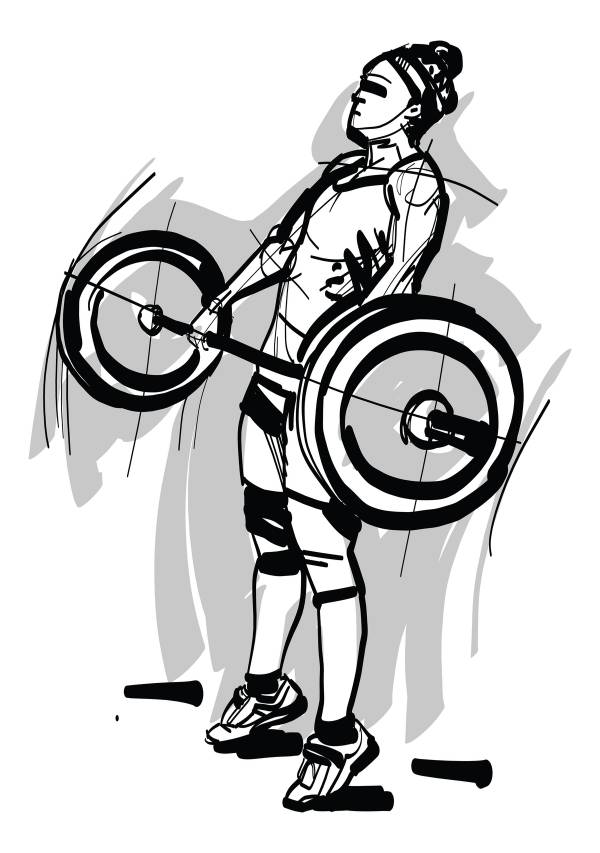Photo By Bev Childress
Photo By Bev Childress
Is Olympic-style weightlifting just a different form of plyometrics? This question has been bouncing around the strength and conditioning community for quite a long time. The answer, however, is right in front of our eyes. Verkhoshansky and Siff left a good amount of breadcrumbs along the way. Let’s follow the path and connect the dots.
Is plyometric training just a question of jumping, hopping, skipping and leaping? Well, if we obey the definition of plyometric we surely can’t disagree. The stretch-shortening cycle seems to be the one and only criteria that defines what is plyometric and what is not. It’s encrypted in the name itself “plyo”, from the Greek “to increase”, and “metric” meaning “length”: what if we replace the prefix “plyo” with “power”? How would that sound?
In their book, Supertaining, Siff and Verkhishansky redefined the concept of jump training by describing the “mechanics” of plyometrics in terms of speed, kinetic energy, and ground reaction force ultimately deriving a model that applies to more than just depth jumps and drop jumps. They called it “power-metric” and they defined it in terms of mathematical, almost algebraic equations which are, for the majority of us, quite difficult to digest.
I guess we should have expected such a scientific approach, in the end, we are talking about a mechanic engineer (Siff) and one the most brilliant sports scientist of the last century (Verkhishansky). It is possible, however, to identify and simplify a few of these complicated equations and derive some of the basic principles in power-metric; principles that underline the many similarities between plyometric training and the pull in Olympic weightlifting. Let’s start from where we left off: what are the three distinguishing characteristics of plyometric training?
1. The Pre-Stretch
What about a snatch? Or a clean and jerk? The active, concentric muscle action of the quadriceps muscles during the first pull results in the eccentric contraction (pre-stretch) of the hamstrings and glutes. It is a basic reflex, known as reciprocal inhibition. As the knees are extending, knee flexors are stretched until the second knee bend begins.
It’s “stretching” but it’s under load.. shall we call it “eccentric load”? Nothing dissimilar than what we experience landing from a depth jump.
2. Eccentric Overload
During the first pull, the active contraction (eccentric contraction) of hamstrings and glutes prevent the trunk from changing its angle compared to ground. Namely, as hamstrings and glutes are “stretching” (see point 1) they are also generating force to preserve the angle at the hip joint throughout the entire first pull.
What about elastic energy? We learned eccentric pre-stretch=elastic energy. Should we change our mind just because we call it Olympic weightlifting and not “shock method”?
3. Peak Power Output
For the pull in weightlifting to be effective, the transition between first and second pull must be as quick and reactive as possible. Any delay will result in lack of proper speed coming from the power position, “wasting” the elastic energy stored in the muscle-tendon complex during the moments preceding the second pull. A fast, explosive eccentric to concentric muscle action does, eventually, result in greater peak power output making Olympic-style weightlifting exercise some of the most powerful strength training exercises.

Bringing Weigtlifting and Plyometrics Together in Training
Olympic-style weightlifting exercises are the most explosive movement an athlete can perform in the weight room. As explosive as a vertical jump, like John Garammher, demonstrated back in the late ’70s. Are they plyometric in nature? The answer, now, seems pretty evident. Here is the way plyometrics and Olympic-style weightlifting can come together in the training of athletes:
For a beginner athlete: vertical jumps and box jumps can help young and/or beginner athletes to learn the basic in training without having to deal with more complicated movements such as the snatch, clean and jerk. Basic jumping exercise have a great degree of similarities with the pull in Olympic weightlifting and they can be used to teach proper body mechanics and to develop overall strength and coordination.
For an intermediate athlete: high impact plyometric training goes hand in hand with Olympic style weightlifting. Jump training emphasizes speed over the strength (speed strength) while snatch, clean and jerk emphasize strength over speed (strength-speed). They complement each other as they represent an excellent way of distributing training volume and intensity within each micro and mesocycle.
For an advanced athlete: Olympic-style weightlifting exercises and plyometric drills fit into a more organic progression that goes from general strength training (GPP) to sport specific training. Snatch, clean and jerk become the surrogate for strength training during the pre-competition period whereas plyometric – especially low impact plyometrics – takes over as the season begins in the effort to further improve speed, power, and agility.
Olympic-style weightlifting exercises can be considered as the most athletic-like form of shock method.
Reference
1. Enoka, R. M. “The Pull in Olympic Weightlifting.” Medicine and Science in Sports 11, no. 2 (1979): 131–37.






